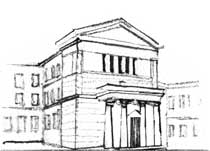Leopold Infeld Colloquium
2006/2007 | 2007/2008 | 2008/2009 | 2009/2010 | 2010/2011 | 2011/2012 | 2012/2013 | 2013/2014 | 2014/2015 | 2015/2016 | 2016/2017 | 2017/2018
2007-03-08 (Thursday)
Prof. Stanisław Mrówczynski (Akademia Swiętokrzyska, Instytut Problemów Jądrowych)
Instabilities Driven Equilibration of the Quark-Gluon Plasma
Experimental data suggest that the quark-gluon plasma produced at the early stage of relativistic heavy-ion collisions reaches equilibrium within 1 fm/c. Inter-parton collisions seem to be "slow" to equilibrate the system so fast. However, due to anisotropic momentum distribution the parton system is unstable with respect to the chromo-magnetic plasma modes. These color instabilities appear to effectively isotropize the system and thus speed up the process of its equilibration. A whole scenario of the instabilities driven equilibration is reviewed.
2007-02-22 (Thursday)
Prof. David Langlois (APC, Paris)
Glimpses of the early universe
This talk will give an overview of the theoretical ideas in our current understanding of the early universe. I will show how cosmological observations, in particular cosmic microwave background fluctuations, give usa remarkable window on the physics of the early universe and what we hope to learn from future observational data.
2007-01-25 (Thursday)
dr Jakub Tworzydło (IFT UW)
Przejście klasyczno-kwantowe w koherentnym transporcie elektronów przez kropkę kwantową
Przedstawię własności transportowe elektronów w układzie mezoskopowym, na przykładzie balistycznej, chaotycznej kropki kwantowej. W eksperymencie grupy z Bazylei w 2001 r. zaobserwowano skończoną skalę czasu Ehrenfesta w takim układzie. Czas Ehrenfesta pozwala rozróżnić deterministyczny, krótkoczasowy ruch elektronów od długoczasowego chaotycznego rozpraszania funkcji falowej. Dla zaniedbywalnego czasu Ehrenfesta własności układu mezoskopowego są dobrze opisane teoria macierzy przypadkowych (RMT). Przedstawię modelowe, numeryczne wyniki dla szumu śrutowego i fluktuacji przewodności, które wykraczają poza uniwersalność RMT. Półklasyczna teoria pozwala wyznaczyć parametryczna zależność od czasu Ehrenfesta i daje dobra zgodność z uzyskanymi wynikami.







